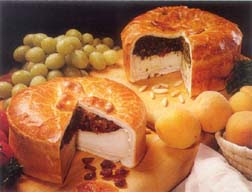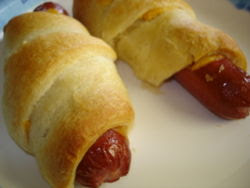Tuesday, June 26, 2007
Pie quote of the day.
--Demitri Martin
Saturday, June 9, 2007
Pie quote of the day.
- Jim Gaffigan
Sunday, May 20, 2007
Pie Breakdown
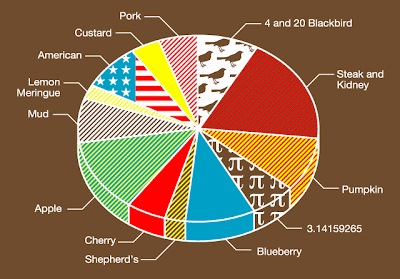 (borrowed from Threadless Ts)
(borrowed from Threadless Ts)The tale of Four & 20 Blackbirds dates back at least to the 18th century.
Also present here, we have Shepherd's Pie - not to be confused with Cottage Pie.
Though I am somewhat confused by the apparent popularity of Steak and Kidney pie in the chart presented......
Thursday, April 26, 2007
Friday, April 13, 2007
Pie without Pi != Pie
In addition to the crust changing, the integration of Pi seems obvious. Pigs in a blanket is not pie - they are best associated with some malformed toplogy discussion. One could argu that the 'pig' has both pi and Pi, but the thing to remember is that this is only a minor part of the whole experience. "PiaB" is a filthy abomination on the Eyes of the Pie Vatican because of the unweildy shape and desperate attempt to infiltrate the pure and holy realms.
Perogi - not pie. They are oblong (at best) and Pi wants no place in the perverse universe of the distorted purity of Pi Pie. While super yummy, they are most definitely not pie.
While some of you may disagree, I believe the following link will prove and validate my (The Church's) opinion that Pie without Pi is like an abusive relationship without a Fist Hickey : linky
Thursday, April 5, 2007
Pie Town, New Mexico: Town of Pie
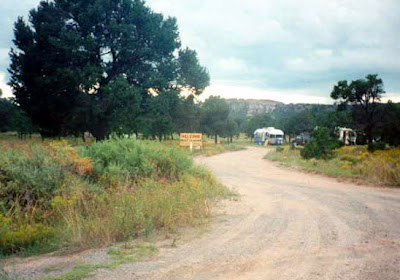
Folks, this here is Pie Town, New Mexico, site of an annual pie festival, held in September. I will be in Pie Town three weeks from now; in other words, six months too late. They better still have some pie when I get there. And I don’t mean pigs-in-a-blanket, or sausage rolls, or pierogi, or some kind of Peter Framptom thingummy.
I get the impression that there is not much of interest to the pie scientist in Pie Town. Seems like it’s just pie, pure and simple and indisputable. I will be prepared for any crazy unexpected anomaly of course, but this town will probably be of more interest to the pie historian, pie documentarian, and pie glutton. You may be sure I will investigate matters thoroughly on that basis.
Expect my report mid-May. Until then, content yourself with this 2005 Smithsonian article about the history of Pie Town, New Mexico: Town of Pie.
Monday, April 2, 2007
Humble Pie, more heart than Peter Frampton
 Since it has been argued that pigs in blankets are pie it occurs to me that other esoteric discussions about pie should neither be off limits.
Since it has been argued that pigs in blankets are pie it occurs to me that other esoteric discussions about pie should neither be off limits.To consider it "pie," humble pie requires a living, breathing definition of "pie" – and a whole lotta heart, I've come to find out. Let's explore.
In order for a gastronomic object to be pie, “the crust needs to undergo a physical change,” I’ve been told. Must the object be culinary? Must this change occur in an oven? Or can the crust be figurative crust, changing within one’s gut or one’s spirit? Must the crust even exist in a tangible form?
For argument’s sake: When one eats humble pie one’s public humiliation should aid one in undergoing some sort of change. But whether the humble pie in question is actually pie depends on whether the figurative pie gets into one’s heart and transforms its figurative crust. If one eats humble pie only to save face because one has been caught doing the wrong thing then one will not change. If one realizes one has made a mistake and in turn eats humble pie, it is possible that one’s heart, like that of the Grinch, could grow several sizes. Former: not pie. Latter: pie, arguably.
If a nourished, changed soul cannot be comfortably described as “changed crust” then allow me to posit that humble pie is TOO GOOD to be pie. Even though it is the humblest of pies.
The term we’ve come to know as “humble pie” did begin as an actual pie. “Humble,” meaning of course “lowly,” and “of lesser quality.” Humble pie was “made of the inferior parts of the deer,” according to Random House’s Word of the Day. Innards, hearts, etc. The parts were known as “humbles.” Hunters and later servants ate them up with a, er, spoon, I’m assuming.
What is a little contradictory, though, is that the word “humble” to describe the pie came originally from the Latin “lumbulus,” meaning “little loin” which later became, in bustling fourteenth century France, “numbles” or “nombles,” meaning “loin of beef, veal or venison.” The word did not originally mean the crap parts.
Later some Brit, dropping ‘is pronunciation of the “h” as many Brits are wont to do, asked for “a numble pie,” which sounded like “an umble pie.” The whole thing eventually morphed into “humble pie” nodding to the connection between the lowly quality of the ingredients and the definition of the then modern-day definition of “humble.”
Many British of course continue to fancy the business of linguistic connections, what with their wild Cockney rhyming slang. In fact, “strawberry tart” is slang for “heart.” And “Isle of Skye” is slang for “pie.” Could one ask for a “strawberry tart Isle of Skye” and receive a pie full of organ meat? I don’t know – I didn’t go into Burger King.
As an aside, writer/chef extraordinaire Anthony Bourdain would have one believe that the lowliest parts of the animal are often the most delicious. They have to be, because it has always been more difficult to make the less expensive parts taste delicious and so innards and the like have had a long and evolving seasoned relationship with humans putting tremendous care into making them taste good. (Whereas something as expensive as beef tenderloin is, while expensive as heck, virtually flavorless because of its lack of fat. What is, tenderloin, really, other than an expensive object to dip into béarnaise?)
But I digress. Pie. Right.
Decree: While I believe that naming and colloquy are very important in the classification of pie (regardless of whether Wikipedia neglects to mention it), I must say that the band, Humble Pie, is not a pie. I believe (and you do not have to agree) that in order to be considered at least loosely a pie, even if cake-like, the object in question must not only be called pie but must also be loosely shaped like the most common pie-shape of the time (right now we're in The Round Pie Time). While the band, Humble Pie, is called “Pie” it is not in a round shape. Though, it could be argued that the living members of the band are rounder now than during the height of their popularity and so are in some ways closer to being actual pie than they were. Hell, their crust has also certainly changed over the years.
Friday, March 30, 2007
Pierogi - small filled pies. No shit.
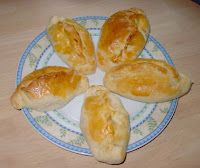 I've been eating pierogi for a while now and I never would have thought to call them "pies." After all, I (and most people--"people" being Americans) boil or fry them, right? Turns out that's because I wasn't making them from freakin' scratch like these crazy Russians. All of a sudden it makes sense. Hello, PIErogi! Duh.
I've been eating pierogi for a while now and I never would have thought to call them "pies." After all, I (and most people--"people" being Americans) boil or fry them, right? Turns out that's because I wasn't making them from freakin' scratch like these crazy Russians. All of a sudden it makes sense. Hello, PIErogi! Duh.FYI: In Russia a pierog (russ.: пирог) is a big pie with one filling. Small pierogi are called pierozhkí (russ.: пирожки).
Brie En Croute
Sunday, March 25, 2007
What to Make of This?
The first pies, AKA Pig In Blanket IS TOO PIE
From Answers.com:
So a turnover-type dish is not only pie, it is the FIRST PIE. That makes it more pie than any of the graham-cracker crust FAKERS. But "wait," you say, "a turnover is only rolled dough also." Not true. According to Wikipedia, turnovers can have either short or "puff pastry dough."Even into the nineteenth century, the pocket pie in its most ancient meaning lingered on alongside the newer forms in both demotic speech and literature, especially in cookery books of a highly colloquial nature. The unifying principle was that they were considered finger food during a period of English cookery predating the introduction of forks—quite literally something broken or cut into pieces. Indeed, this idea of eating with the hands has persisted for a very long time and is still preserved in such American creations as the Pennsylvania Dutch shoofly pie, a breakfast cake baked in a pie shell and meant to be sliced, held in the hand, and dipped into strong coffee.
This marriage of very different types of pies under the umbrella of one term is further linguistic evidence that the turnover shape was indeed the oldest type and that the English language did not have a wide range of indigenous terminologies to accommodate the newer forms. It is also evidence that the transition from one form to the next was sometimes gradual, especially in the countryside. Food historians generally concur that there is a definite genealogical link between the ancient pie and its modern two-crust descendant, although there is no firm agreement as to how this transition took place. There are several possible avenues of evolution. The shallow dish or saucer pie and the deep dish or potpie offer two theoretical possibilities.
A pie is any non-dough food baked into and with a dough crust, of any type. Filled croissant, pie. Shepherd's pie, not a pie. Any "pie" with graham cracker crust, not a pie. Pigs in a blanket, PIE!!!
Also, baked ravioli
Saturday, March 24, 2007
Boston Cream "Pie:" Not a Pie.
Dear BCP,
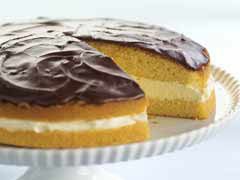 I think it's about time that you came to terms with it. You are not a pie. At best, you are a cake. At worst, you are a donut. How or why you came to be called a "pie" is beyond me. You obviously were feeling insecure about the fact that you lack the proper frosting coverage to be truly respected as a proper cake. And what's with your filling? What is that, pudding? Custard? See now, if you put that pudding into a pie crust, you would have a perfectly legitimate pudding pie. But nooooo, you had to put the pudding in the middle. And the only baking going on with you is the sponge cake. Yes, that's right, cake.
I think it's about time that you came to terms with it. You are not a pie. At best, you are a cake. At worst, you are a donut. How or why you came to be called a "pie" is beyond me. You obviously were feeling insecure about the fact that you lack the proper frosting coverage to be truly respected as a proper cake. And what's with your filling? What is that, pudding? Custard? See now, if you put that pudding into a pie crust, you would have a perfectly legitimate pudding pie. But nooooo, you had to put the pudding in the middle. And the only baking going on with you is the sponge cake. Yes, that's right, cake. Dude, give it up. You are such a poseur.
Your friend,
Amy
The experts...
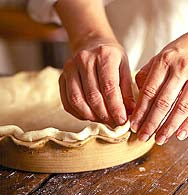
Madeleine Kamman, author of "The Making of a Cook", includes pies only in her section on rolled pastry. The pies have one, one-and-a-half (like lattice), or two crusts; they may be shallow or deep (tarts or deep-dish); and their contents may vary (she includes a French country recipe for Belgian Endive-and-onion pie). The key is the dough type, which is a soft pastry dough, rolled out but not kneaded. It is different than puff pastry dough, and it is different than croissant dough. Therefore I am forced to contend that piggies-in-a-croissant-or-bread-dough-blanket do not qualify as pie.

